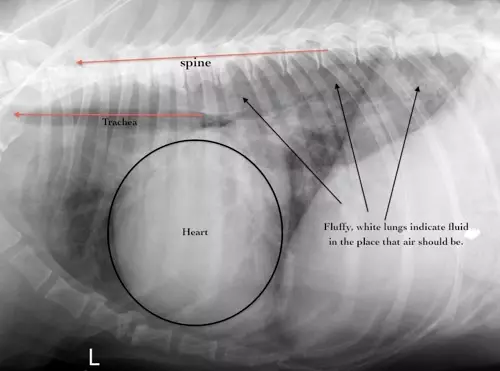Dilated Cardiomyopathy (DCM) in Dogs (NAVLE Notes)
Dilated cardiomyopathy (DCM) is a common cardiac disorder in large and giant dog breeds, characterized by weakened heart muscle, ventricular dilation, and reduced contractility, often leading to congestive heart failure (CHF).
Classic Case
- Breeds: Doberman Pinscher, Boxer, Great Dane, Irish Wolfhound, Standard Poodle, Cocker Spaniel.
- Age: Middle-aged dogs are commonly affected.
- Signs:
- Early: Heart murmur, weak peripheral pulses, exercise intolerance.
- Progression: CHF signs like cough, tachypnea, dyspnea, tachycardia, weakness.
Diagnosis

- Radiography:
- Generalized cardiomegaly.
- Variable venous dilation.
- Pulmonary edema or perihilar infiltrate if CHF is present.
- Electrocardiography (ECG) / Holter Monitor:
- Ventricular ectopic beats are common.
- Dobermans may have early ventricular arrhythmias.
- Atrial fibrillation in advanced disease.
- Holter monitoring helps assess arrhythmia severity and guide therapy.
- Echocardiography:
- Left atrial and ventricular dilation.
- Possible mitral and/or tricuspid regurgitation.
- Poor contractility: prolonged end-point septal separation (EPSS), decreased fractional shortening (FS).

Treatment
- Prior to CHF Onset:
- ACE Inhibitors: To reduce cardiac workload.
- Pimobendan: Positive inotrope and vasodilator if heart dilation is evident.
- Anti-arrhythmics: Sotalol or mexiletine for ventricular arrhythmias.
- After CHF Onset:
- Acute Therapy: Oxygen, stress reduction, parenteral furosemide, and pimobendan.
- Chronic Therapy: Oral furosemide, ACE inhibitors, and pimobendan.
Key Points
- Prognosis:
- Dogs with occult DCM may live several years, but sudden death from arrhythmias is a risk even before echocardiographic changes are apparent.
- Pimobendan started prior to CHF onset can delay CHF development and extend life expectancy, though prognosis remains poor after one year in CHF.
- Additional Causes of DCM:
- Taurine Deficiency: Linked in American Cocker Spaniels, Golden Retrievers, Boxers, Dalmatians.
- Carnitine Deficiency: Seen in Boxers.
- Chagas Myocarditis: Caused by Trypanosoma cruzi.
- Parvovirus: Rare, typically due to in utero exposure.
- Doxorubicin Toxicity: Cumulative doses >180 mg/m² can induce DCM.
- Feline DCM:
- Breeds: Siamese, Burmese, Abyssinian.
- Poor prognosis, as most cats present in CHF. Diagnosis and treatment are similar to canine DCM.
NAVLE-Style Practice Questions on Dilated Cardiomyopathy
Question 1
A 6-year-old male Doberman Pinscher is presented for exercise intolerance, weakness, and cough. Physical exam reveals a weak pulse and a heart murmur. Thoracic radiographs show generalized cardiomegaly and mild pulmonary edema. What is the most likely diagnosis?
- A) Hypertrophic cardiomyopathy
- B) Dilated cardiomyopathy
- C) Mitral valve disease
- D) Pericardial effusion
Correct Answer: B
Explanation: The clinical presentation, breed predisposition, generalized cardiomegaly, and pulmonary edema are consistent with dilated cardiomyopathy, a common disease in Doberman Pinschers.
Question 2
A 5-year-old Great Dane has been diagnosed with early-stage dilated cardiomyopathy without signs of CHF. What is the recommended treatment to delay the onset of CHF?
- A) Beta blockers
- B) ACE inhibitors and pimobendan
- C) Furosemide and oxygen therapy
- D) Antiarrhythmics only
Correct Answer: B
Explanation: ACE inhibitors and pimobendan are effective at delaying CHF in early-stage DCM. Furosemide and oxygen therapy are reserved for active CHF cases, while beta blockers and antiarrhythmics may be used if arrhythmias are present.
Question 3
A Boxer with dilated cardiomyopathy is monitored with a Holter device. The results show frequent runs of ventricular tachycardia. What is the appropriate intervention?
- A) Initiate ACE inhibitors only
- B) Start antiarrhythmic therapy with sotalol or mexiletine
- C) Discontinue all medications and monitor
- D) Administer furosemide and oxygen therapy
Correct Answer: B
Explanation: Ventricular tachycardia in DCM requires antiarrhythmic treatment, with sotalol or mexiletine being effective options. ACE inhibitors may help but are not specifically for arrhythmias, and furosemide is used if CHF signs are present.
For study notes visit cracknavle.com